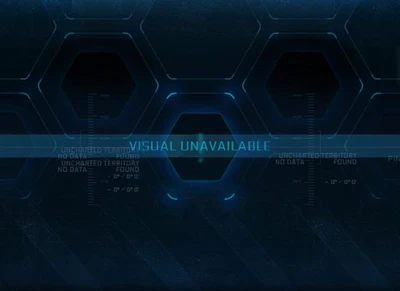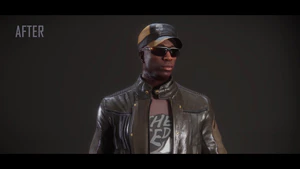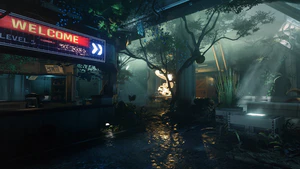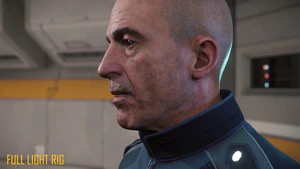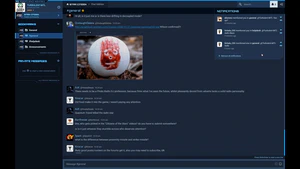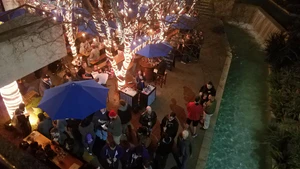Greetings Citizens,
Welcome to the monthly report where we collect updates from our studios around the world into a single comprehensive place to summarize the various progresses (and setbacks) they’ve experienced.
This past month has been a flurry of activity. Aside from making headway on S42 and the PU 3.0 undertaking, we launched 2.6.1 to the entire community and have been working on 2.6.2.
Anyway, enough with the intro, let’s get to some updates.
CIG LOS ANGELES
Tech Content
Led by Sean Tracy, the Tech team worked with engineering to tackle the new damage system, which creates random and organic damage effects via procedurally generated materials and exposes the ship’s internal skeleton when metal melts away. They also worked on adding physics-driven destructible behavior to Item System 2.0 by converting the existing functionality into the new Item 2.0 health and damage system. Networking, Persistence, and VFX functionality are also being improved to extend destructibility to broader classes of entities, including props.
The tech content team also worked with animation to implement facial idles for ship pilots. Additionally, they developed a tool that marks up zones used by the renderer to hide and show different areas on a character mesh when layered pieces of clothing and armor are equipped. For example, if your character is wearing a shirt, and then you put a jacket on, the zone culling tells the renderer to ignore any part of the shirt that is out of sight. One of Tech Content’s contributions to this powerful feature was to create a tool that automatically zones and splits any number of assets, regardless of topology. This allows us to quickly implement the zone culling feature onto our massive database of character art.
Recently, tech design also worked on two prototypes. The first was based off Chris’ initial vision for the interaction system, the interface by which players will be able to control and manipulate various objects, such as ships, control panels, weapons, and more. Once they roughed out the system, they worked with programming and UI to ensure that the prototype’s functionality was not only clear on what we’re trying to achieve, but actually possible.
The second prototype focused on how the player controls the properties of items (like shields, weapons, and thrusters) so they can manage signals generated by entities like space ships. This work allows players to manage their ship emissions and engage in a stealthy gameplay. The prototype also explored how to change the properties of these items, so the team can determine how to make upgrades more desirable. It also fixed our previously limited system, which couldn’t be easily balanced, and provided a much more direct way to implement gameplay with simple numerical values.
Tech content is also deep into the setup of the Cutlass Black, Buccaneer, the re-work of the RSI Aurora and another ship we can’t quite discuss yet.
Finally, they’re taking a pass at updating our ship stats page on the website, so all the information about our ships will contain the most current specs. As part of this change, they plan on having regular updates about each of our ships moving forward.
Engineering
The engineering team worked on Instance Properties, which allow designers to modify any part of an entity component in Editor or Game. With this feature, designers do not have to create tons of similar entity templates, simply expose some parameters to modify within the editor itself. This will save asset storage space and reduce the number of entity components, while also allowing for more variations.
With the ultimate aim of creating seamless transitions through our entire universe, the engineering team is making progress on Object Container streaming by changing core engine code to radically increase the amount of content we can put in the game without sacrificing performance. They’re currently replacing the old prefab system in both the hangars and shops with an Object Container to prepare for this expected streaming.
On the radar front, we’ve added an extra timer value to the object data bank, which will be used to specify how much time an entry can remain as an echo contact. They also implemented the Metadata Component interface, which is a component that can be attached to any entity to make them radar detectable. In addition, a feature that allowed object databank linking and unlinking was added, so that entities will inherit databank entries from their parent which lets a player inherit information from the ship they are currently in.
Engineering worked on new scanner gameplay, specifically a mechanic that allows you to reveal hidden information about radar objects. Lastly, the team worked on Lighting States, so various altered states will reflect certain situations, like low power or emergency lockdown. This can currently be done using layer-switching but it requires duplicate lights for each state and has no options for transition animations. They developed a new entity called a Light Group that will take control of all the lights that are assigned to it. With its own internal state machine, the Light Group can modify its lights depending on the current state, for example, switching from a normal light state to an emergency light state and back.
Art
Over on the character side, the art team moved further down the pipeline on many new outfits. For Squadron 42, they created costumes for the deck crew, which presented an interesting challenge as they work a variety of jobs, some of which are in the vacuum of space. The deck crew outfit is coming along nicely in the high poly modelling phase. They also continued working on the Explorer space suit which was featured in our newsletter. They completed final texturing and sent it to rigging, which allows us to get it tested in-game. Finally, they worked on the heavy armor class for both Marine and Outlaw. The Heavy Outlaw will move into the high poly modelling phase once approved, while the Heavy Marine was handed off to rigging before it’s finally implemented.
Narrative
This month the Narrative team fleshed out the game’s alien races with Britton, our xenolinguist, to help develop their various languages. Great strides have been made, as members of the Narrative team can now be heard cursing in Xi’an around the office. The team also worked with artists and designers on various needs for 3.0 and Squadron 42. These include the lore behind various weapon and damage types, the look of planet specific NPC characters and the extensive text needs for Squadron 42.
Meanwhile, they continued to crank out weekly dispatches, a number of exclusives pieces for Jump Point, a wide-range of marketing materials, and much more. On the subject of marketing materials, the Narrative team also welcomed a new member this month, copywriter Desirée Proctor, who has been a great help in tackling things like ship brochures, manufacturer lore and component descriptions
Finally, archivist Cherie Heiberg worked with several departments to find the right database solution to catalogue and sort through the massive amount of animations that will be used in game.
CIG AUSTIN
Player Relations
Over at the Austin Studio, Player Relations travelled to the Foundry 42 and Turbulent offices to work on ways to better collect and distribute feedback that can be used during Evocati and PTU Waves during testing. At the same time, Player Relations helped test and launch both 2.6.1 and Spectrum.
Live Ops
The Server Engineering team has been supporting both live and the upcoming 2.6.2 patch. They also continued to enhance multi-region support for matchmaking. Fixes and tweaks have been made to the Party system and Contacts and Friends, which includes improvements to invitations and online/offline state notifications. The Austin Studio has directed much of their energy towards the new Diffusion architecture for the back end services. Diffusion allows the studio to easily create stateless micro services by combining C++ and Ooz scripting languages, which allows the creation of scalable and high-performing stateless services that will allow a larger number of concurrent players with improved stability and less downtime. All of the current back end services have been updated to run on the Diffusion core, which permits refactor/rewrite services for Diffusion without impacting current service operations. Finally, the new Diffusion API Gateway has been finished, which allows Spectrum and other external services to seamlessly integrate with the Diffusion network.
February marked the smooth launch of multi-region support for the LiveOps/DevOps team. The heavy lifting was directed toward the network and server side of our services which resulted in a relatively trouble free rollout for us. A good portion of our early development and testing was on the network to ensure the most reliable connections between the US, Germany, and Australia regions. The entire team was happy to see that the additional work paid off with performance and stability as expected. This allowed the team to move directly into writing enhancements to our monitoring and reporting tools.
Lighting
The Lighting team is working on initial lighting passes and polish passes for some of the locations in Squadron 42. The team is also doing some general optimizations and polish work on Retaliator and Constellation, among others. These changes will fix the infamous strobe lighting in the Retaliator cockpit, as well as improve performance inside these specific ships.
Ship Art
This month, the Drake Cutlass Black entered the greybox phase, so the Ship Art team added primary and secondary detail with geometry and material work. The team was able to kit bash pieces from the Caterpillar, add more details and complete a first lighting pass for the interiors.
Animation
The Austin Ship Animation team wrapped up the greybox phase of the mining ship, the MISC Prospector, with the UK Team. The Drake Buccaneer is getting finalized animations while the team also works on the Cutlass Black.
The PU Animation Team continued to create animations for NPCs to interact with the environment. One of these animations includes replacing the rough retargeted animations on the female with properly shot animations of female performance. They made progress debugging issues with animation, skeletons, and the animation pipeline in general, by working with Code and Design to create a better system to implement the hundreds of animations that have been developed.
One of Animation’s goals has been to create an entire eating experience for NPC characters at the Idris mess hall tables. The sequence begins with a character grabbing a tray and navigating to a table’s seat. Then, the character will sit, eat, drink, and perform any other actions. Finally, the character will stand with the tray in hand and navigate to the tray disposal. This exercise will actually incorporate almost all the departments and will answer a lot of questions about pushing the boundaries of natural NPC behavior.
Design
This month, the Design team worked on getting the first pass implementation of trade into the game with the goal of having a functioning, fluctuating economy that mirrors the real world in as many ways as possible. A few things are required to make this happen: the initial list of commodities must be developed, as well as the locations in which to buy and sell them, and a variable economy needs to be implemented. This economy will include goods flowing from their mined or gathered states, then onto the refineries, passing through manufacturers, and ultimately turning into buyable or tradable items. The price of these items will be an important element of gameplay, because player’s actions can impact the flow of resources, which will in turn affect supply and demand. Since this is still in the early stages, Design outlined a basic structure to represent major commodity groups: Ore, Gas, Food, Medical Supplies, and Vice (like drugs or other illegal items). That way, players can get an idea of which resource types will be traded or fought over. Once the system has been tested with the small subset, Design can expand the commodities into more specific things like Gold, Hydrogen, Rations, Bandages, and more. Next, places are needed so players can purchase and offload this cargo- once you buy it, refine it, and manufacture it.
Design has also been outlining the types of stores that will start to make their way into the PU. In the discussions about the new Truck Stop, it became apparent that all stations have the need for a certain level of resources to sustain their existence and thought that it was a little weird to sell resources directly to the shops themselves, so a new shop type was created. The Admin Office will focus on buying and selling station imports and exports for the local stores on the stage. This shop would also control Local Storage Rentals and include a job board to complete and plan deliveries. This shop type will be in the majority of the locations that don’t have a full-fleshed out Trade and Development Division (TDD), which is focused more on commodity trading.
Ultimately, the prices of commodities will vary based on the supply and demand of the dynamic economy, but, for testing purposes, commodity prices will be set by hand and stay within range of their base prices.
QA
For the month of February, QA Austin primarily focused on testing and supporting the release 2.6.1, and preparing for 2.6.2. This has included compiling comprehensive patch notes for both 2.6.1 and 2.6.2, daily checklists, and working with our UK QA counterparts to increase familiarity with the release process. Multiplayer Megamap and serialized variables have both been major focuses of attention. At the same time, Austin QA hired four new testers while also wrapping up their annual reviews for the existing team members leading to several corresponding promotions (congrats!). We have also been ramping up our attention on the Game-Dev stream as new tech comes online, to ensure stability for both Squadron 42 and 3.0 development.
IT & Operations
The IT team has been involved in multiple projects expanding of our internal build system infrastructure. Content continues to flow in through the ‘source – build – replication’ pipeline at an increasing pace so our infrastructure must occasionally grow along with it. The current upgrades are focusing on network and compute resources in the build system itself so we can isolate stability testing environments from production. In addition to reducing build times to some extent by reducing contention, we will also be able to double capacity for internal code testing further ensuring our engineers don’t have to wait in line. Soon after, the IT team will be shifting back to centralized storage growth but this time with a renewed focus on performance.
FOUNDRY 42 UK
The UK office has expanded somewhat since the last monthly report. There have been 22 new hires this year which brings the number up to 201 employees in the Wilmslow office and 9 developers at the new Derby Studio which mainly focuses on facial animation. To house everybody, we’ve been doing some remodelling in the office and even taken over another floor.
Programming
We have completed a sprint of the Player Interaction System, which improves how the player interacts with items or picks up objects. This system also incorporates the new highlighting and inner thought systems. This will allow players to have a more intuitive and accessible UI experience and clearly identify what they can interact with.
The team have continued work on the new mission system. The old flowgraph missions, which were not scalable to the needs of our dynamic universe, are going away to be replaced with a tool that can create diverse and systemic missions much more rapidly. Our Design team have already started using this tool to set up missions in the PU. The Frankfurt update will delve a little deeper into this, but the design team have started using the new System Editor tool, known as “Sol-Ed,” to put together our system maps which will really increase the productivity of our design teams.
The teams also completed two locomotion sprints. The first was to blend the walking-to-run and run-to-walk animation to better capture a more realistic sense of speed and inertia for the player. The second sprint was to vastly improve AI path following, so NPC characters are able to traverse close spaces and blend between animations in a much smoother manner.
Our Graphics team has been working to optimizing the lighting in the game. One major part of this work is to upgrade the quality and accuracy of rectangular lights. In most games, rectangular lights are not used very often due to their very high cost, but our artists have been requesting support due to the prevalence of these types of lights in our game, so we’ve spent a lot of time optimizing our shaders to make them viable. In addition, the team has improved the diffuse lighting and reflections to mirror real world behavior, which have had a tremendous effect on our character lighting.
On the Networking side, the team is finishing off the serialized variable, which will reduce network bandwidth for the PU. They also finished the new message queue to stabilize sending and receiving of packets and are continuing to hammer out bugs with the new Multiplayer Mega Map, so players can switch between game modes without long load times.
Animation
The Animation team has been pretty weapon-centric over the past month. They worked on reload, firing, hand poses and select-and-deselect animations for the current line of FPS weaponry in the game. They also worked on updating the no-weapon locomotion, the stocked sprint, prone combat animation and revised the female rig based on feedback.
As outlined in earlier discussions, managing your character’s stamina and oxygen has always been a part of SC’s ultimate FPS system, so the team started pre-visualization sprints to start locking down exactly how those animations would look and how that would affect gameplay.
The Derby studio continued to focus on S42 characters, but also found time to support the team for 3.0 characters including some of the mission givers as well as bartenders, shopkeepers and general population lines.
Art
The Concept team has taken a second pass on weapons to improve reload visuals and add detail where needed while working on some new ship weapons.
The Ship team has been putting the final touches on the exterior of this Javelin Destroyer, as well finishing work on the interior decks. This ship is an important one on several levels, not only be involved in the first instalment of Squadron 42, it will be available in the PU as our new capital ship mechanics like item port 2.0, come online.
Work is ongoing with the MISC’s hopeful entrant to Murray Cup, the Razor, while large strides have been made on the Hull series of cargo ships. They have been specifically tackling some of the major functionality questions about the ship: how the cargo arms will work, how they will load and unload cargo, or land. It’s been quite a challenge given the huge difference in carrying capacity from the smallest class “A” to the massive Class “E.”
The Environment team has continued with Squadron 42 work, but has also started early work on several locations that will turn up in the PU, like the Truck Stop. By utilizing the modular building sets, they’ve been able to mock up exteriors and interiors rather quickly to show the variety of locations we will be able to place in the PU. It’s been a great process, allowing the team to keep the art style consistent, while accommodating the functionality required by design.
The planetary surface outposts finished their initial art sprint to complete the base building set, so the team can create small outposts in multiple configurations and distributed across different landscapes. Now we have our building blocks, we can start adding flavor and details. Also, with the surface outposts, the team is developing how our shaders are going to react when we place these architectural elements in various biomes which will help give us believable systemic integration into their environments without having to invest lots of art time to create bespoke assets.
Lastly, as you know, space is very large, so while a lot of attention has been placed on detail the locations, moons and planets, the question was raised about how to make areas of space feel distinct and interesting. The Environment team has been syncing up with various departments to explore investing time in creating the visual targets for our space look and feel, whether travelling through anything from a nebula or dense asteroid field to a space storm or anomaly.
VFX
The Visual Effects Team has been focused on a lot of planning to help support our new planetary environments; including atmospheric flight effects and modular/ procedurally generated surface bases. Work has been done on thruster and damage effects for the Constellation Aquila and updates to the high tech damage effects library. The team has also iterated on last month’s explosion template and provided further polish to ballistic SMG weapons.
UI
This month, the UI team has progressed on our new Kiosk shopping interface, proven out by our prototype which allows us to make sure it works in all our locations and shop types. They’ve also continued to improve all our in-game HUD UI whether walking around, or on a ship.
Audio
Aside from supporting all the various sprints and requests from the other departments, the Audio team fixed up performance issues and tool improvements, created audio for new ships including the Dragonfly, Connie Aquila, and Prospector, worked on the music for both S42 and the PU, submitted fixes to weapon audio and finally implemented foley work so the right noises can be heard from differing material types.
FOUNDRY 42 DE
Cinematics
Coordinating with multiple disciplines across all our world-wide studios, the Cinematics team has been pushing forward on the rich storytelling of Squadron 42 in order to achieve the final look and feel that they are after. Thanks to the efforts of the Character team our A-List cast of characters is looking better than ever, which not only helps with immersion but also to express a fuller and richer range of emotions. One of the big focuses this month has been working with the UI and Art teams on refining the inner thought system and how Players will interact with it.
Weapons
The FPS focused part of the team have been working on the final polish passes for newest additions to the Behring and Klaus and Warner lines, as well as a new double-barrel ballistic Ravager shotgun from Kastak Arms. The ship weapon team have been focusing their time on finalizing the pipeline for the new modular and upgradeable system which, when completed, will allow greater flexibility for players, as well as allowing artists to create the weapons themselves more efficiently. An example of this is the work that is being done on updating the Knightsbridge Arms line.
Tech Art
This month, Tech Art worked on a tool for both cinematic and gameplay animators to quickly render out previews of their work in Maya by offloading the rendering to a different PC. This allows them to continue working during the render process, greatly expediting the workflow. The renders are an essential part of the review process since they assist the global team being able to see everyone’s progress across all the studios. In addition, the Tech Art team also worked on other numerous small tasks such as skinning, cloth, and automate file testing in Maya, and supporting the weapons team to name a few.
Engineering
The Engineering team focused much of their efforts on pushing the planet tech we have been developing even further. One notable step forward has been with planetary clouds. The team revised LOD computations for cloud textures in order to reduce aliasing and shimmering artifacts in the distance. Cloud animations have progressed as well making them even more realistic, and for creating a wider range of worlds, the artists now have the option to tint the clouds with various colors.
They also completed a first iteration of the Solar System Editor. This was an important tool for us to develop since the size of our solar systems and the amount of objects within them made other previous workflow methods exceeding difficult to use. This new editor allows our designers and artists to set up solar systems by dragging in planets as object containers, configuring their orbits around the sun, setting up moons orbiting around planets, and more.
The team completed numerous other improvements such as replacing the video player backend to allow for much higher quality videos at a much reduced file size. They also worked on compression and enabled client side feature testing on a large variety of game and engine features to automatically track if and when new submissions cause any unexpected errors.
AI
The AI team has recently completed two separate sprints related to the implementation of the subsumption mission system’s functionalities. These sprints used research and rescue missions in Crusader to test the expanded functionality and provide the groundwork for additional missions to be added with the subsumption system. One of the low level features added is the super GUID which provides a way to connect a variable in subsumption to an object in the world. For example, in Crusader, we had one main object container that defines the Stanton System. This container has a clear structure and contains asteroid fields, Port Olisar, etc. In the mission logic, we can have multiple super GUID variables that allow us to access specific elements within a given structure which will benefit the implementation of some of the richer mission designs.
This month the AI team also introduced a new tool, the subsumption visualizer. This tool allows designers to debug mission and behavior logic in realtime and make adjustments and modifications to the flow and NPCs on the fly which significantly cuts down iteration time. This tool is fully integrated into the engine and will be the central place for the debug functionalities of subsumption as a whole.
Usables have also been a large focus, and now system designers can have both the player and the AI interacting with the same usable, and intelligently be able to use objects inside of that usable. For example, sitting down at a table, picking up a cup, drinking from it, using a knife and fork, picking a grenade from a locker, etc. They in addition worked on getting all of the SQ42 character subsumption behaviors standardized across the board and using the same fixed template for conversations and 24 hour life cycle behaviors.
VFX
Over the past month, the VFX team has continued work on the procedural systems for placing particles on the surface of planets. They’ve also been working with the system designers on a brand new oxygen breathing system and the visuals attached to it. As players perform various actions in game, the oxygen system visuals will help inform the player of their exertion level. The system is still incredibly early in its development and may change, but has been showing good progress.
Level Design
The Level Design team is continuing its push on modular locations including surface outposts for hydroponics, mining, and storage. Of course, as with the other locations, both the interior and the exteriors of these outposts are modular, allowing designers to quickly create a wide variety of locations for players to explore while still maintaining the high level of visuals Star Citizen strives for.
Environmental Art
The Environment team has continued the development of the procedural tech and have been working directly with the programmers to improve the tools. The team has made a lot of progress on the procedural moons around Crusader, making sure that Yela, Cellin and Daymar each have their own distinct look and feel. A lot of effort has gone into making each one unique, but at the same time visually tying them to the overall look of Crusader. The work for the different ecosystems on these moons is now complete and the team is currently working on redefining the geological elements that will be found on each separate moons.
TURBULENT
The Turbulent team has been working away on Spectrum, checking the Issue Council for reported issues and identifying short term additions to the platform. Two of the releases that have been launched came directly from user feedback with the goal of releasing updates every two weeks. The team has added better readability on a thread list and tweaked sort algorithms based on user requests. They also incorporated timestamps to the threadlist and worked on allowing users to add inline media. They also aim to bring thumbnails to the threadlist and secondary thread types, since only classic threads exist. An upvote system for comments within the forum thread is in development.
The Turbulent team also stopped in Los Angeles and the UK to discuss in-game integration between platform and game. This integration will make Spectrum unique to other platforms as it will be the only one entrenched in Star Citizen. Another longer-term goal is different command channels. For example, a Squadron type channel that allows Admirals and Captains to broadcast to sub-channels when needed.
A Spectrum mobile app is Turbulent’s major focus. At the moment, Spectrum is mobile-ready via your phone’s web browser. There are still a few bugs, however, so the team is working to bring native support to the mobile platform, beginning with Androids and iOS. The goal is to get the mobile platform to a point where it’s easier for users to get notifications.
One of their long term goals is voice support, which is currently in research and development. They’re working through a lot of different technical options to get simple voice chat in. Once it’s implemented, users can take advantage of this feature while playing Star Citizen. As with everything in Spectrum, Turbulent would like to launch features fast and then improve upon them with the help of users.
COMMUNITY
The Community team added two important new members this month, Graphic Designer Javid Kazmi and Community Manager Tyler Nolin. Tyler will be operating from the Los Angeles office and you can expect to see him everywhere you Star Citizen. Please make him (and all our new employees) feel welcome on Spectrum!
On the subject of Spectrum, Turbulent has done some amazing work on getting this new communication hub up and running, and the dev team has been having a great time interacting with the community in the new forums and chat channels. If you see the gold name of a team member, don’t hesitate to reach out as we’re eager to hear your thoughts, discuss the game, and get to know all of you better. As for the legacy systems, by the time you read this, the old live chat will have been retired and preparations will be underway to transition the forums fully to Spectrum.
Also this month, CIG’s very own Jared Huckaby and Tyler Witkin travelled to snowy Boston to share Star Citizen with the masses gathering for PAX East, the East Coast’s largest gaming convention… and by all accounts, it sounds like it was a success. Check out these snaps from the massive Bar Citizen event.
In addition, the Community team kicked off the Anvil Hurricane promotion, which introduced the UEE’s toughest new fighter to our ranks. The Hurricane is a heavily armed ‘glass hammer’ of a ship which is intended to expand existing gameplay with a unique variation. For the promotion, a ‘warbirds’ style brochure was introduced along with a new kind of Ship Shape. Both were followed by two rounds of community Q&A that you can read here and here.
There have also been some exciting changes to the community weekly video lineup. An all-new style of 10 for the Chairman premiered with Chris being joined by Tony Zurovec to talk about cargo and mining professions in 3.0. Here’s a clip!
The new community show, Citizen’s of the Stars has been off to a great start, but it needs YOU! The show wouldn’t exist without incredible Citizens doing amazing things, so be sure to share your cool projects on the Community Hub whenever you can. We also need your questions for ‘Quantum Questions,’ which you can provide in the Subscriber’s Den. For more information about becoming a Subscriber click here .
Star Citizen’s Friday livestream, Happy Hour has become more diverse than ever, with a new set of ‘theme’ episodes that will make things more unique each week. Different programs will feature interviews, retro gaming and even live art prototyping! There’s something for everyone, so why not stop by and hang out.
Getting into the ‘nuts and bolts’ of how the Community team operates, representatives from around the company gathered for a week-long Community and Marketing sync up to discuss the exciting events, promotions and releases we have coming this year including some events that are happening this week at SXSW! John Erskine, Tyler Witkin, Eric Green and Merissa Meissner will be appearing on a panel talking about Community interaction, Evocati testing and more. The panel is set for this Saturday, 12:30-1:30 on the Geek Stage at the Austin Convention Center, Room 6AB so swing by if you can.
Thank you, everyone, for your support. Star Citizen can only be as good as the community that supports it… which means that we’re in good hands! We’ll see you in the ‘verse.
CONCLUSION
See You Next Month…
That will do it for February’s Monthly Report. Be sure to tune into Around the Verse next week to get a new update from the LA studio about their work on female characters, light group entities and the Aurora rework, followed by a trip to Frankfurt the week after where we’ll get updates from Animation, Lighting and AI.
Thanks again for your support and we’ll see you in the ’verse.
